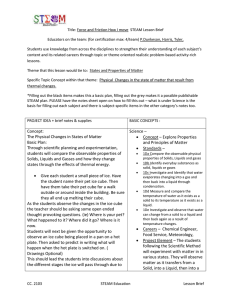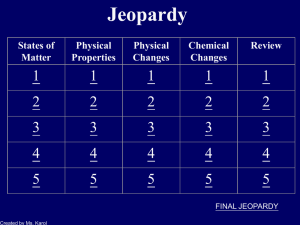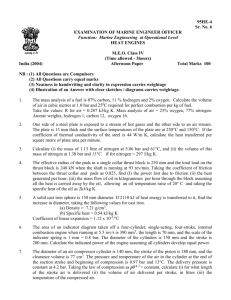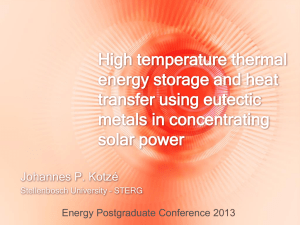82deb8058e68772bea837b3b1775a3b3
advertisement
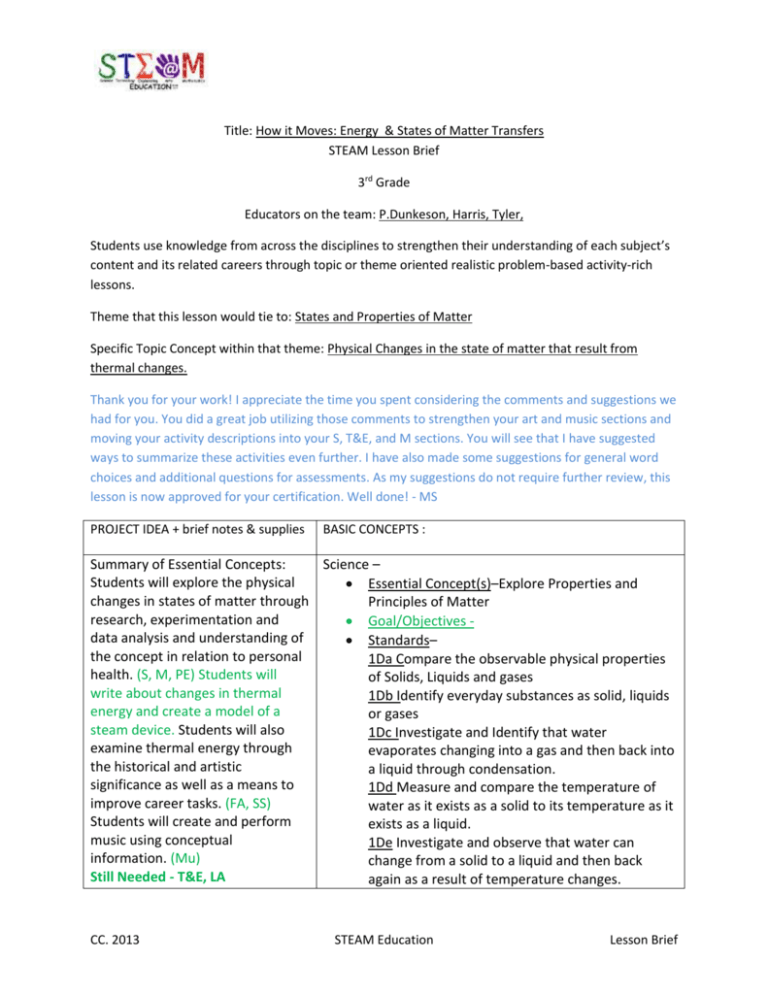
Title: How it Moves: Energy & States of Matter Transfers STEAM Lesson Brief 3rd Grade Educators on the team: P.Dunkeson, Harris, Tyler, Students use knowledge from across the disciplines to strengthen their understanding of each subject’s content and its related careers through topic or theme oriented realistic problem-based activity-rich lessons. Theme that this lesson would tie to: States and Properties of Matter Specific Topic Concept within that theme: Physical Changes in the state of matter that result from thermal changes. Thank you for your work! I appreciate the time you spent considering the comments and suggestions we had for you. You did a great job utilizing those comments to strengthen your art and music sections and moving your activity descriptions into your S, T&E, and M sections. You will see that I have suggested ways to summarize these activities even further. I have also made some suggestions for general word choices and additional questions for assessments. As my suggestions do not require further review, this lesson is now approved for your certification. Well done! - MS PROJECT IDEA + brief notes & supplies BASIC CONCEPTS : Summary of Essential Concepts: Science – Students will explore the physical Essential Concept(s)–Explore Properties and changes in states of matter through Principles of Matter research, experimentation and Goal/Objectives data analysis and understanding of Standards– the concept in relation to personal 1Da Compare the observable physical properties health. (S, M, PE) Students will of Solids, Liquids and gases write about changes in thermal 1Db Identify everyday substances as solid, liquids energy and create a model of a or gases steam device. Students will also 1Dc Investigate and Identify that water examine thermal energy through evaporates changing into a gas and then back into the historical and artistic a liquid through condensation. significance as well as a means to 1Dd Measure and compare the temperature of improve career tasks. (FA, SS) water as it exists as a solid to its temperature as it Students will create and perform exists as a liquid. music using conceptual 1De Investigate and observe that water can information. (Mu) change from a solid to a liquid and then back Still Needed - T&E, LA again as a result of temperature changes. CC. 2013 STEAM Education Lesson Brief Basic Plan: Students will be given a pet ice cube to garner interest in the concept. Through scientific planning and experimentation, students will compare the observable properties of Solids, Liquids and Gasses and how they change states through the effects of thermal energy. (S) Students will analyze data as they measure elapsed time for the transfers of energy to occur. (M) Students will create graphs and complete comparisons to articulate data gathered. Students will research careers that use thermal energy and create a model to improve the career of their choice. (T&E???) Students will explore thermal energy on a personal level by engaging in activities in the PE/Health classroom designed to simulate sweating and be able to describe the concept as it applies to their personal health and wellbeing. (PE) Students will participate in a thermal energy activity and take notes about their discoveries. Students will then create a presentation from the perspective of a popcorn kernel to describe thermal energy and the transfer of the state of matter. (LA?) Students will also create an perform an original piece of music.(Mu) Students will also explore the historic significance of steam on society in the past and in the future. (SS) Students will develop an understanding that Thermal Energy – STEAM energy impacted not only industries and CC. 2013 Careers–Chemical Engineer, Food Service, Meteorology, Project Element–The students following the Scientific Method will experiment with matter in in various states. They will observe matter as it transfers from a Solid, into a Liquid, then into a Gas. They will then experiment with the observations in the reciprocal process to find a common causality. Students will first be given a pet ice cube to take for a walk and observe the ice cube melting. Students will then experiment with water and record observations as the state of matter transfers to a Solid, Liquid and then into a gas. Students will place a single ice cube in a pan on a hot plate then The teacher will first place an ice cube on a hot plate and ask students to then predict, in writing, what effect the transference of thermal energy will have on the ice cube and observe the resulting effects when the hot plate is switched on. Students will explain and draw the changes to record key details and concepts as they work together. The class will discuss the stages the ice will pass through as it melts. A collection of ice cubes will be placed in a pan on the hot plate. Students will take temperature recordings in time intervals in which they will also record/draw their observations until the water begins to boil. Students will be required to consider: How does the temperature affect the state of the ice cube? Is it a slow change (over years) or fast change (minutes/hours/days)? Through scientific planning and experimentation, students will compare the observable properties of Solids, Liquids and Gasses and how they change states through the effects of thermal energy. Give each student a small piece of ice. Have the student name their pet ice cube. Then have them take their pet cube for a walk outside or around inside the building. Be sure they all end up melting their cube. As the students observe the changes in the ice cube the teacher should be asking some open ended thought provoking questions. (e.g.) Where is your pet? What happened to it? Where did it go? Where is it now?Students will next be given the opportunity to observe an ice cube being placed in a pan on a hot plate. Then asked to predict in writing what will happen when the STEAM Education Lesson Brief careers but also the artistic world through the ability to travel as well as a through the current movement of STEAMpunk. How Popcorn Pops http://www.kidzworld.com/article/ 547-how-popcornpops#ixzz3K0yRvAt2 Popcorn Popped Popcorn Before It's Popcorn Popcorn is a tasty addition to any movie night but it's also an example of some pretty cool science. Check it out! How Popcorn Pops - The Wet Truth Although popcorn kernels may look totally dry, each kernel of popcorn CC. 2013 hot plate is switched on. ( Drawings Optional) Summarized above. This should lead the students into discussions about the different stages the ice will pass through due to the increase in thermal energy provided by the hot plate. Summarized above. Hot plate activity: The students will each place one ice cube into the pan on the hot plate. The hot plate needs to be set in the off position, and a meat thermometer should be placed on the inside of the pan, until all the cubes are placed inside. Next, one student should be assigned the task of turning on the hot plate to the high setting and report the first temperature reading. Students should put on safety glasses and be allowed to walk up and look into the pan on a pre-assigned time schedule, every 3-5 minutes to observe and record what they see and the temperature readings. After each viewing the student should immediately return to his/her reporting station and write and draw what he/she has just seen on the recording sheet. The students will discover, as the heat rises, the ice cubes will melt faster. As steam starts to rise from the pan students should be allowed one last trip the see the water boiling. Then the teacher should be the only person reading the thermometer for the duration on the experiment.(Surfaces will be hot!) Summarized above. Explore questions: How does the temperature affect the state of the ice cube? Is it a slow change (over years) or fast change (minutes/hours/days)? Moved above to your project. Whole Class discussion: Lead a class discussion about vaporizers in the home. Vaporizer uses a water tank than then changes it into steam to fill the room and add moisture to the dry air. The room fills with steam and after an hour or so, the vaporizer tank is empty. Moved into your extension. STEAM Education Lesson Brief actually has a tiny amount of water inside it. This water is stored inside a circle of soft starch inside the kernel's hard outer surface. As the kernel heats up, the water's molecules start to move faster and get farther away from each other; this molecular expansion is the same reason water turns into steam when you boil it. As the water expands it puts pressure against the hard starch. Something's gotta give - so eventually the water pressure wins out and the popcorn ruptures. The soft starch inside becomes inflated and bursts, flipping the kernel inside out to release the steam inside! Mmmm, popcorn! Technology & Engineering – Essential Concept(s) –Describe the change of state of matter when ice is heated. Also the movement from a Solid to a Liquid and then into an evaporated Gas state. When cooled the process will reverse. Goal/Objectives Standards–Use real world examples to explore transference of thermal energy through the states of matter. Careers–Hydro-electrical Engineer, Heating and Cooling Technician, Food Tech., Meteorology, Rocket Scientists, Steam Engineers, Turbine Engineers Project Element– During science, students will place a single ice cube in a pan on a hot plate then predict, in writing, what effect the transference of thermal energy will have on the ice cube and observe the resulting effects. Students will then work in small groups to write a report about a career that uses steam power during social Limited Don't freeze popcorn or keep it in the fridge. This dries out your kernels and without moisture there won't be any poppin'. Those kernels you find at the bottom CC. 2013 1Da Compare the observable physical properties of Solids, Liquids and gases 1Db Identify everyday substances as solid, liquids or gases 1Dc Investigate and Identify that water evaporates changing into a gas and then back into a liquid through condensation. 1Dd Measure and compare the temperature of water as it exists as a solid to its temperature as it exists as a liquid. 1De Investigate and observe that water can change from a solid to a liquid and then back again as a result of temperature changes. Popping corn on the cobCourtesy of Thompsons Popcorn - Did U Know? Assessment–The students will explain both in writing and using drawings how matter changes its state by the application or reduction of thermal energy. Extension - Students will discuss how thermal energy is used in everyday situations. Lead a class discussion about vaporizers in the home. Vaporizer uses a water tank than then changes it into steam to fill the room and add moisture to the dry air. The room fills with steam and after an hour or so, the vaporizer tank is empty. STEAM Education Lesson Brief of the bowl that failed to pop are called old maids. They were too dry to have any pop left in them. The English colonists were introduced to popcorn at the first Thanksgiving feast in 1621 when Quadequina, brother of Wampanoag chief Massasoit, brought a deerskin bag of popped popcorn to dinner as a gift. Read more: How Popcorn Pops Grade Level:3 studies. They will then build a model matching the steam device used by that career. This device should be designed to heat and evaporate, collect, condense and cool water. Students will be asked to consider how they could improve upon this device. Assessment–Students will self-evaluate their model Were the students able to create functioning models? Do they understand why their model did or did not work. Were students able to explain how their device could have been improved upon? Were students able to describe how this device is utilized in the career they researched? and determine if it would be able to use enhance and improve the career they researched. Extension – Students will explain the transfer of thermal energy using a real-world examples and how their model would transfer energy. Timing of Lesson: Approximately five to seven days of 45-50 minute lessons. Including discovery walks and activities, direct instruction and then time to read, time to draw and take Math – pictures, time to develop a Essential Concept(s) –Measure elapsed time in presentation. minutes Goal/Objectives Basic Supplies: Standards–Solve problems involving All Subjects: Ice cubes, hot plate, measurement and estimation of intervals of time, pan, spray bottles, tongs, leather liquid volumes, and masses of objects. gloves, goggles, stopwatches, Careers–Hydro-electrical Engineer, Heating and thermometers, paper, classroom Cooling Technician, Meteorology, Rocket supplies, popcorn, oil, jump ropes, Scientists, Steam Engineers, Turbine Engineers. fan, musical score, soundtrack Project Element–Student will read the measurement of time it takes for water to freeze, to melt in your hand, to evaporate in pan on the Other Resources: hot plate, and to condense back to liquid in the aluminum can. Students will compare times between the groups of students and find the Misc: mean, median and mode times that it required for the transfer of energy to occur. Students will create a chart detailing the data from their measurements. Students will analyze and make Photos: predictions about why or how the elapsed time differed for each state of energy transfer. excellent! CC. 2013 STEAM Education Lesson Brief LA – http://g01.a.alicdn.com/kf/HTB1cL THIpXXXXcRXXXXq6xXFXXXI/TwoSisters-On-the-Terrace-PierreAuguste-Renoir-Painting-MuseumQuality-Reproduction.jpg http://1.bp.blogspot.com/_BBmO m1l_P08/TPhfcpyAqLI/AAAAAAAA A1w/MCpcuurocVY/s1600/The+Ga re+Saint-Lazare-Arrival+Of+A+Train+%25281877++Claude+Monet%2529.jpg SS – http://news.discovery.com/earth/s CC. 2013 Assessment–Students are able to measure and record times from a stopwatch or timer. Students create a chart analyzing elapsed time data accurately. Essential Concept(s) –Read and relate an everyday item to a scientific principle. Goal/Objectives Standards–Describe the relationship between a series of historical events, scientific ideas or concepts, or steps in technical procedures in a text, using language that pertains to time, sequence, and cause/effect. Careers–Science Teacher, Math Teacher, Cook, Technical Writers, Farmers Project Element– Students will engage with the teacher in the How Popcorn Pops lesson and take notes as the lesson progresses. (See lesson on right left side) Students will create a presentation to explain the changes of a popcorn kernel as it is heated. Students will determine the type of presentation and the medium they will use to share with the class. The presentation must be 35 minutes in length and describe the effect of changes in thermal energy through the perspective of a popcorn kernel. Assessment– Students are able to communicate information about their learning to classmates. Did students accurately include language that pertained to time, sequence, cause and effect? Extension – Discuss and connect the transfer of thermal energy as it affects people’s lives. Essential Concept(s) –Steam power was the key to the Industrial Revolution, driving all new technologies. Goal/Objectives Standards– SSE5- Describe how changes in communication and transportation technologies affect people’s lives. STEAM Education Lesson Brief teampunk-plastic-ocean-art121121.htm https://www.pinterest.com/pamel apooleart/sketchbook-inspirations/ Careers–Civil Engineer, City Planner, Environmental engineer Project Element–Students will work in small groups to write a report about a career that uses steam power. They will then build a model matching the steam device used by that career. Assessment–Students will be graded on their knowledge of steam power and must include the significance of steam power on society in the past and future as a part of their report. Students will also be assessed on their ability to convey their understanding in writing and writing conventions. Art – CC. 2013 Essential Concept(s) –Steam power allowed artists to travel, gave freedom to painters and other Impressionist artists in the Industrial Age. Transfer of Energy is the basis of an artistic movement: STEAMpunk Goal/Objectives Standards– IV1A- Compare the art and music of a particular culture. (Time and era) Careers– Painters, sculptors, architects, historians Project Element–In order to fully understand the historic significance of steam power, students will take a walking field trip. They will be taking a sketch pad, colored pencils, and crayons. Students will be drawing an outdoor scene away from their “studio” as the Impressionist artists got out during the Industrial Age. Students will also research STEAMPunk art and create a piece using found items to represent the art movement. The piece must fit within a 4x4 square and students will describe orally or in writing how the artistic piece is an example of steampunk and its relation to thermal energy or the transfer between states of matter. Assessment–Students will be assessed on their ability to identify the impact of STEAM power on art. Students should be able to describe the impact of travel on an artist and the STEAMPunk movement. Extension – Students will have an art show and STEAM Education Lesson Brief display and share information they have learned with educational stakeholders. PE – Essential Concept(s) –Physical movement causes the body to sweat as a method to cool the body through evaporation. Goal/Objectives Standards– PA1A Recognize the components of health-related fitness (cardio respiratory endurance, muscular strength and endurance, flexibility, and body composition) Careers– Coach, Personal Trainer, Athlete Project Element–Students will participate a period of cardio exercise to increase heart rate and to induce sweating. Students will be sprayed with a water bottle to simulate sweating. The evaporation rate will be timed and recorded with different variables: hand dryer, fan, ambient air, shaking. Students will determine the average time of evaporation for each method. Assessment–Students will be assessed on their ability to identify the purpose of sweating and to articulate verbally the connection between sweating and thermal energy. Students will be assessed for their accuracy of determining which method produced the fastest evaporation rate. Extension –Students will compare the evaporation rates with the elapsed time data conducted during math class to articulate new findings about thermal energy and the transfer of matter. Music – Essential Concept(s) –Movement in Music Goal/Objectives Standards– M1A-Identify characteristics of teacher selected genres or styles: Play, party, folk dances, folk music Careers - Musicians, choreographers, composers, circus performers, calliope Project Element–Students will learn the background of folk/working music in early CC. 2013 STEAM Education Lesson Brief America through learning “I’ve Been Working On the Railroad.” Students will watch YouTube videos about heat and energy transfer. Students will then create song to the tune “I’ve Been Working on the Railroad” about thermal energy and/or transfer of states of matter. Heat Transfer Song https://www.youtube.com/watch?v=wr8Z4SCETPs The Heating Song https://www.youtube.com/watch?v=SYnP4TGOGRY Heat energy song https://www.youtube.com/watch?v=khZrs-UBq28 CC. 2013 Assessment–Students will present their song including scripted movements or actions to the class. Students will have to explain why they chose the movement and actions and how they pertain to the concepts in the song. Extension – Students will create a video of the song they created. STEAM Education Lesson Brief

